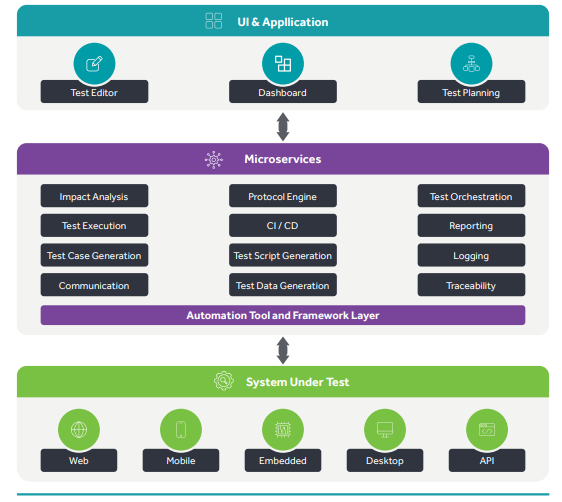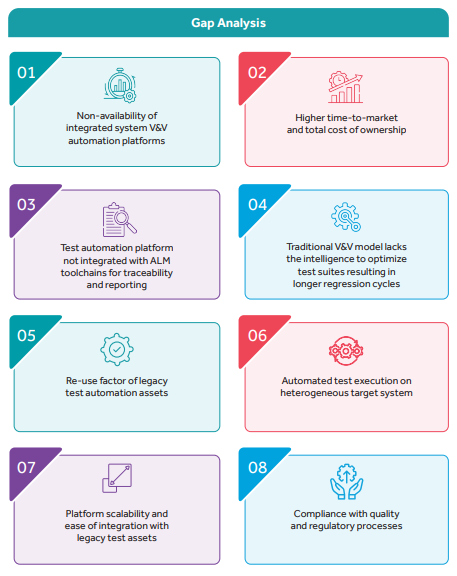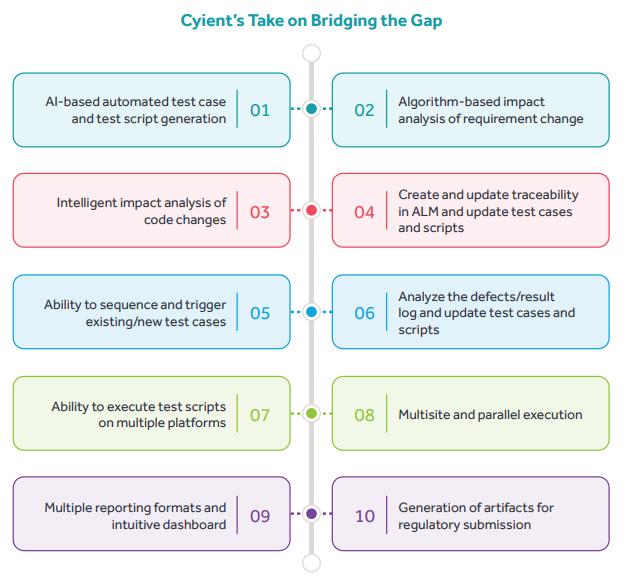
Testing software is valued by organizations that believe in timely delivery of quality software to stay competitive. This white paper explores the current state of end-to-end system test automation, upcoming trends, and how organizations can be empowered to achieve their quality goals with reduced test cycles and agility. It also does gap analysis and proposes Cyient’s AI-powered end-toend system test automation solution to bridge the gap.
High-quality, reliable testing of software requires longer test cycles, skilled test engineers, time, effort, and money. If a test approach is incorrectly chosen, a small change in software or in software configuration may have a ripple effect on test efforts which may cost an organization dearly.
Managing testing of software that is meant to run in a distributed environment and on multiple platforms is complicated. It is not just test execution but test creation too that requires significant effort by SMEs and needs continuous effort to manage every change and update to the software.
The most sustainable way to efficiently deal with these challenges is to embrace an efficient, reliable, easy-to-use test automation solution that predicts, auto generates, and simulates business use cases with minimal or zero human intervention. The first step in this direction is identifying and choosing the right test automation framework, approach, and process for end-to-end system test automation. With rising demand to execute longer duration tests multiple times for multiple host environments for systems like Web applications, Windows applications, mobile applications, IoT, and embedded devices, the test automation framework has to be executable on heterogeneous platforms, reusable, and scalable. To achieve the same we need to understand the current state of test automation.

Testers and developers must work together to ensure that the testing process goes smoothly. Testing, and especially automated testing, can lead to hang-ups during the “handoff” phase.
It is critical that the development team understands the basic working of the automation tool to ensure the application lends itself to automation.
There are several places where communication can break down and cause problems. Testers may misunderstand goals, while developers may fail to incorporate feedback from testers into improving code quality
Today, there are a variety of testing tools ranging from free and open-source tools to commercial tools supporting different testing types and technologies. Each tool tends to support a particular situation.
Depending on the nature and extent of automated testing for AUT and technical and business expectations, teams need to do research into the tools, and also consider the available budget before making a choice
Automation increases testing velocity but requires a significant investment in front-end capital. It is a hard sell to management because a “payback” period can be unpredictable or protracted. The biggest way to ensure positive ROI after comprehensive testing automation adoption is to analyze, design and build a test automation framework, libraries, or reusable functions that integrate with other products in the ecosystem.
Testers need to identify the right test automation approach to match their needs. To do that, they must ask themselves questions such as:
This is especially important if you are working in an Agile environment where the tested application changes regularly and test automation needs to be implemented in a way that recognizes these changes, keeping the team up to date with a costeffective maintenance strategy.
That is why you should consider getting an automation solution that detects these issues and automatically updates or re-validates the test.
Test automation requires specific technical skills to accurately design and maintain the test automation framework and test scripts, build solutions, and resolve technical issues. Automated testing resources need to have indepth knowledge of the framework’s design and implementation. To fulfill these job requirements, resources need to have both strong programming skills and solid test automation tools.
Test automation helps you reduce the feedback cycle and bring faster validation for phases in product development.
Automated tests can be executed significantly faster than manual tests, and are less error-prone and labor-intensive. Once written, the tests can be executed any number of times at no additional cost. The tests are also available 24/7, unlike manual testers.
Newly developed features can be continuously tested and validated with test automation. This reduces the feedback and testing cycle and allows companies to bring their products to the market faster.
At first, building your automated test suite is a challenge. However, once you have defined your suite, it is simple to reuse tests for other use cases or even other projects. The advantage is that you can easily hook up another project to your automated test suite.
Once you have gained a thorough understanding of setting up an automated test suite and all related tools such as the continuous integration (CI) pipeline, you can easily replicate this knowledge to set up your test automation for a new project.
Automation allows you to spend time writing new tests and adding them to your automated test suite. This increases the test coverage for your product, so more features are properly tested resulting in a higher quality application.
Also, automated testing allows developers to write more in-depth tests that test complex use cases. Lengthy tests that are often avoided during manual testing can be run unattended.
Codeless test automation tools are built on artificial intelligence technology and visual modeling, enabling the accelerated formation of test cases that cater to test automation. Using such advanced automated testing tools, QA engineers can create test case scenarios with zero coding knowledge and reduce the time spent on recurring test cases.
Some of the advantages of codeless automated testing are:
Hyperautomation refers to active automation. When automation is performed using robotic process automation (RPA), ML, AI, and natural language processing (NLP), it is referred to as hyperautomation. Several industries are actively implementing hyper-automation in their processes to minimize manual efforts and save time and money in the long run. With hyperautomation, your organization can easily create your digital twin for enhanced efficiency
Automation testing in the cloud comes with the advantage of low cost, scalability, and easy maintenance. But what is the advantage of a cloud-based tool? With cloud-based tools, you carry out mobile and Web testing in different environments and machines, without setting up your infrastructure.
DevTestOps helps in ensuring that deployment of changes to the systems will be high in quality and require far less time. DevTestOps is expected to enhance the effectiveness of testing and speed up the testing process. The reduction in time will ultimately result in higher customer satisfaction.
The most significant advantage that AI-powered tools provide is the ease of maintenance. They have the ability to heal better. These tools constantly monitor the code and look for changes or patterns. Once they find a change in the application, the tool modifies the test script accordingly.
We can expect to see artificial intelligence apps in more testing zones, most of which will apply to analytics and reports:
Testing of medical devices poses a considerable challenge in terms of cost, effort, and time. This is a critical and challenging phase of the product development life cycle; especially when we have to meet the stringent guidelines imposed by medical device regulations such as IEC 62304 and ISO 14971.
Manual testing can be very expensive and time-consuming, contributing to as high as 60% of the development cost. This is where automation steps in. The benefits of cost-saving through automation significantly outweigh the initial investment.





Automation testing has multiple advantages that make it the top testing method for numerous scenarios. Adequate implementation of automation testing requires the right choice of testing tool and a professional team to exercise it. When choosing an automated testing tool, you should look for one that is flexible and can support a wide range of applications and languages. Cyient’s FAST allows QA teams to create and run the E2E System and functional tests across Web, mobile, desktop, and embedded application and hardware devices, providing a comprehensive environment for building and maintaining automated testing projects.
Cyient’s FAST is aligned with identified megatrends and is a key support to technology-driven disrupters specifically for automation.
Cyient (Estd: 1991, NSE: CYIENT) is a leading global engineering and technology solutions company. We are a Design, Build, and Maintain partner for leading organizations worldwide. We leverage digital technologies, advanced analytics capabilities, and our domain knowledge and technical expertise, to solve complex business problems.
We partner with customers to operate as part of their extended team in ways that best suit their organization’s culture and requirements. Our industry focus includes aerospace and defense, healthcare, telecommunications, rail transportation, semiconductor, geospatial, industrial, and energy. We are committed to designing tomorrow together with our stakeholders and being a culturally inclusive, socially responsible, and environmentally sustainable organization.
For more information, please visit www.cyient.com
Cyient (Estd: 1991, NSE: CYIENT)delivers Intelligent Engineering solutions for Digital, Autonomous and Sustainable Future
© Cyient 2024. All Rights Reserved.